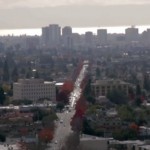On sweltering days you can fry an egg on them. But, now, Lawrence Berkeley Lab and UC Davis researchers are testing surfaces designed to make them cooler and safer.
“Cool pavements are paved surfaces that are more effective at reflecting sunlight. So, by reflecting more sunlight than traditional paved surfaces, they’re able to absorb less heat from the sun and keep cities and communities cooler. We’ve teamed with industry partners and we’re hopeful that this can get the ball rolling on some local government action for cool pavement.”
– Ben Mandel, Heat Island Group, LBNL


